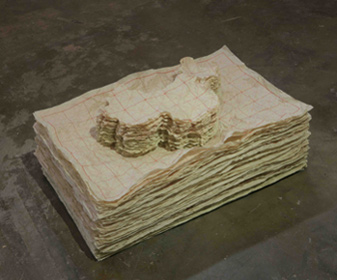02 Apr Susan Stockwell, ‘This and That’ Exhibition and Residency

‘This and That’ Exhibition and Residency, Shenghua Art Centre, Nanjing, China 2005/6.
The residency and exhibition ‘This and That’ took place during December 2005 and January 2006. The Shenghua Art Centre generously hosted two foreign artists at the same time, Susan Stockwell and Kate MccGwire. The artists lived in an apartment in Nanjing and made work in the studios and gallery space at Shenghua, which was exhibited from January to March 2006. An illustrated catalogue called ‘This and That’ was made as a part of the residency
Upon arrival in China Stockwell was struck by the chaos on the roads and by people on bicycles carrying huge layered loads, particularly stacks of cardboard, which teetered precariously on the backs of their rickety bicycles.
On further investigation she discovered an industry of recycling, some Chinese people make a living from collecting and selling cardboard, which they often store in their homes until they have enough to sell by weight in a bale. Recycling is a way of life for some in China, rubbish is sifted and sorted and everything has a use. This pragmatic approach to recycling, different to that in the West, extends to everything from boiling a kettle to keeping warm.
The work made in China investigated issues of recycling, trade and mapping and was made from various papers and card. It took the form of a large scale cardboard installation and two smaller map pieces made from tea bags and rice paper.
Stockwell’s investigation led to sourcing 2.7 tons of cardboard boxes from recycling centres. The cardboard was delivered to Shenghua on a truck. The gallery at Shenghua, a raw cavernous warehouse space invited something monumental. The cardboard provided the answer. Stockwell set about methodically building a cardboard tower 3.5 meters high x 2.7 m square. Layering and interweaving the flattened boxes for strength and stability the tower became a solid rock like form. Referring to both the layered history of China and its present state of flux and change, the used boxes were decaying and grimy, yet beautiful at the same time. The form looked solid from a distance but on closer inspection was mutable and fragile. The surfaces were tactile, irregular and punctuated with colour (especially red from labels and print on the surface of the cardboard). The piece called ‘Paper, Glue, Paper’ is a monolith to the humble cardboard box, highlighting the importance of the everyday and the ordinary, inviting the viewer to question the material by elevating it to a position of monumental beauty.
The two small map pieces, ‘All the Tea in China’ and ‘China Stack’ formed a contrast to the monumentality of ‘Paper, Glue, Paper’. ‘China Stack’ consisted of layers of fragile Chinese Rice Paper (the type used in schools to learn to write Chinese calligraphy on) cut into a map of China. ‘All the Tea in China’, a tea bag map of China makes reference to the history of the tea trade between Britain and China, a trade that Britain profited from at China’s expense.





